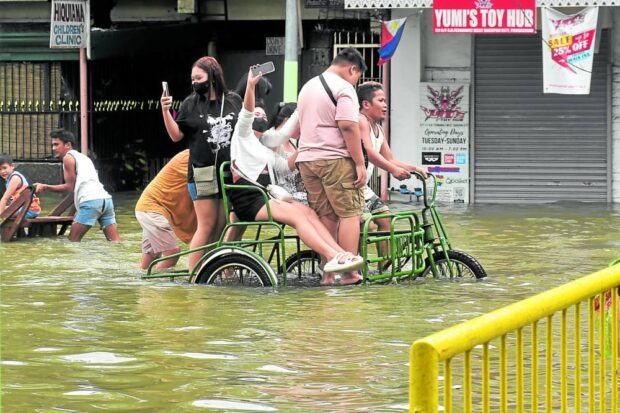Flooding drags in Dagupan

‘FLOOD SELFIE’ Passengers of a pedicab take out their mobile phones for a “selfie” as they pass through a flooded street at the city center of Dagupan on July 30. For more than a week now, a large part of the city has been flooded due to the recent heavy rains, high tide and overflowing rivers. —WILLIE LOMIBAO
DAGUPAN CITY—For more than a week now, this economic hub in Pangasinan province has continued to deal with heavy flooding caused by intense rainfall even after Typhoon “Egay” (international name: Doksuri) had left the country as the southwest monsoon spawned torrential rains in most of Luzon.
All 31 villages of the city, including the central business district, remained inundated as the widespread flooding reached knee-deep (0.60 meter, or about 2 feet) in some parts and rendered some roads impassable for light vehicles.
As a result, “kuliglig” (farm tractors used as improvised trikes) and “kariton” (wooden pushcarts) were seen plying the city’s major routes since cars and other vehicles could not pass through floods. Residents, stuck in their houses, would only go out to buy essentials like groceries and food.
Among them was Susan Yadao, a resident of Barangay Tambac, who said she had to find another public market outside the city to avoid the floodwaters.
“My house was fortunately spared by the flood, but I could not go to Dagupan markets. Instead, I go to the nearby Mangaldan market since it’s not flooded,” Yadao told the Inquirer.
Article continues after this advertisementBusinessman Joseph Lo, who owns a motorcycle and mobile phone store, said the flooding had brought businesses to a “standstill.”
Article continues after this advertisement“We do not open our stores except those in the malls, but our employees are allowed to report to our office so they can still get paid,” Lo said in a separate interview.
Several city streets, like Rizal, Rivera and Galvan, had already been raised in the past few years, but the elevation was not enough to stop floodwater from reaching them.

A woman in Calumpit, Bulacan, checks her phone as she walks through a flooded section of Barangay Frances on July 31. —WILLIE LOMIBAO/LYN RILLON
‘Miserable’
Lo said he visited some of his employees in flooded areas like Malued village, adding that they were in “miserable conditions” as floods hit their houses.
“My employees said they have to sleep on the top level of double-deck beds,” Lo said.
The torrential rains also caused rivers to swell, which contributed to the flooding and was worsened by the rising tide.
On Wednesday, the tide rose to 1.42 meters (4.66 feet), which was a meter higher than the city’s elevation, which is said to be just a meter above sea level. The city was placed under a state of calamity on July 28 in the wake of Egay’s onslaught.
Mayor Belen Fernandez suspended government work and classes until Friday due to the persistent flooding in the city. A report from the city disaster risk reduction and management office (CDRRMO) showed that a total of 1,892 residents in low-lying areas remained in evacuation centers as of Wednesday. According to the CDRRMO, at least 17 fish cages in Cayanga River were damaged by the strong current, with operators reporting P1.8 million in losses. Close to P700,000 worth of rice plants in five villages were also damaged by the flood, the CDRRMO said.
The flooding was reminiscent of the 2018 deluge, when the entire city’s central business district was inundated for almost a month after a portion of the dike in Sinocalan River was breached by rushing water from upstream.
Sinocalan’s headwaters are on Mt. Ampucao in the Cordillera, passing through San Manuel, Urdaneta City, Sta. Barbara, Calasiao and Dagupan City where it is called Pantal River, until it drains into the Lingayen Gulf through a delta at Pugaro village. But floodwater could not readily drain because canals, creeks and rivers crossing the city are in need of massive dredging, said Lo, who once led the defunct flood mitigation commission here.
“Cleaning of the canals must be continuous so they are not clogged and water can flow to the river and into the sea,” he said.
Situation in Central Luzon
In Bulacan province, torrents of water rushed from the mountainous areas in the eastern part, causing floods that rose up to 6.5 feet (2 meters), especially in the towns of Hagonoy, Calumpit and Paombong.
Sen. Joel Villanueva, who hails from Bocaue town, on Tuesday slammed the P183-billion worth of national government flood control project, which he described as a “failure.”
“Bulacan is covered by that flood control project. But look at Calumpit, Hagonoy and Paombong, they are still submerged in floodwater,” Villanueva told the Inquirer after distributing relief goods to flood victims.
He added: “There’s really a problem that should be addressed, and the government flood control program is not addressing this problem.”
In Pampanga province, floods in Masantol town had not been receding and were instead rising as floodwaters draining through the Pampanga River were flowing back due to high tide, silt and garbage at the mouth of Manila Bay. At a press briefing on Wednesday, Masantol Mayor Jose Antonio Bustos said floodwaters could not flow toward Manila Bay because the waves in Barangay Consuelo were higher.
He said the delta should be dredged again to prevent what locals call “back flowing.”
This has been observed to be happening in Macabebe, Sasmuan, Lubao, Guagua and Minalin, according to village officials.
The Pampanga River originates from the Caraballo Mountains and drains out 30 rivers in Central Luzon to Manila Bay.
The dredging of the delta in Masantol and Macabebe, as well as in the Bulacan towns of Calumpit and Hagonoy, has been covered by a feasibility study and is to be financed under the second phase of a Korean-funded flood mitigation project, according to Roseller Tolentino, director of the Department of Public Works and Highways in Central Luzon.
The last time the delta was dredged and widened was in 2000 under the Pampanga Delta Development Project through a 30-year loan from Japan. Signed in 1990, its completion was delayed for 10 years due to opposition by residents who were displaced.
As of Wednesday, all 26 villages of Masantol were submerged in about a meter (3 feet) of water, affecting more than 20,000 families and prompting the evacuation of 1,000 people, Bustos said.